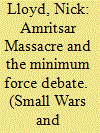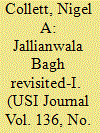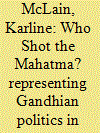| Srl | Item |
| 1 |
ID:
096703


|
|
|
|
|
| Publication |
2010.
|
| Summary/Abstract |
This article re-examines one of the most infamous incidents in British imperial history: the Amritsar Massacre of 1919, and analyses it within the context of the British Army's minimum force philosophy. The massacre has long been regarded as the most catastrophic failure of minimum force in the history of the British Army. This article reconsiders the arguments over the shooting at Amritsar and the role of Brigadier-General Reginald Dyer, and questions the accepted view that the massacre was such a failure of minimum force. It argues that the circumstances surrounding the massacre must be understood before judging the incident and given these factors it is possible to see it within a minimum force framework.
|
|
|
|
|
|
|
|
|
|
|
|
|
|
|
|
| 2 |
ID:
120279


|
|
|
| 3 |
ID:
072459


|
|
|
| 4 |
ID:
167680


|
|
|
|
|
| Summary/Abstract |
Justin Rowlatt, the BBC's South Asia Correspondent, writes a reflection on the 1919 Amritsar Massacre and the 1919 Rowlatt Act, which was a precursor to the Massacre. The author is the great-grandson of Sir Sidney Rowlatt, who was responsible for the 1919 legislation.
|
|
|
|
|
|
|
|
|
|
|
|
|
|
|
|
| 5 |
ID:
077209


|
|
|
|
|
| Publication |
2007.
|
| Summary/Abstract |
Amar Chitra Katha ('Immortal Picture Stories') is the leading Indian comic book series, with 440 mythological and historical titles and sales of over 86 million issues. In 1989, after twenty years of publishing success, the producers of this series decided to release two issues on the world-renowned Indian politician and activist, Mahatma Gandhi. But Gandhi, best known for his technique of non-violent civil resistance, presented a formidable challenge: How to depict the Mahatma, paragon of peace and non-violence, in a visual medium that is notorious for its action and violence? This article examines the relationship between text and image in these comics, and draws upon interviews with authors and artists, to better understand the contested memory of Gandhi in India today as well as the contested concept of non-violence
|
|
|
|
|
|
|
|
|
|
|
|
|
|
|
|